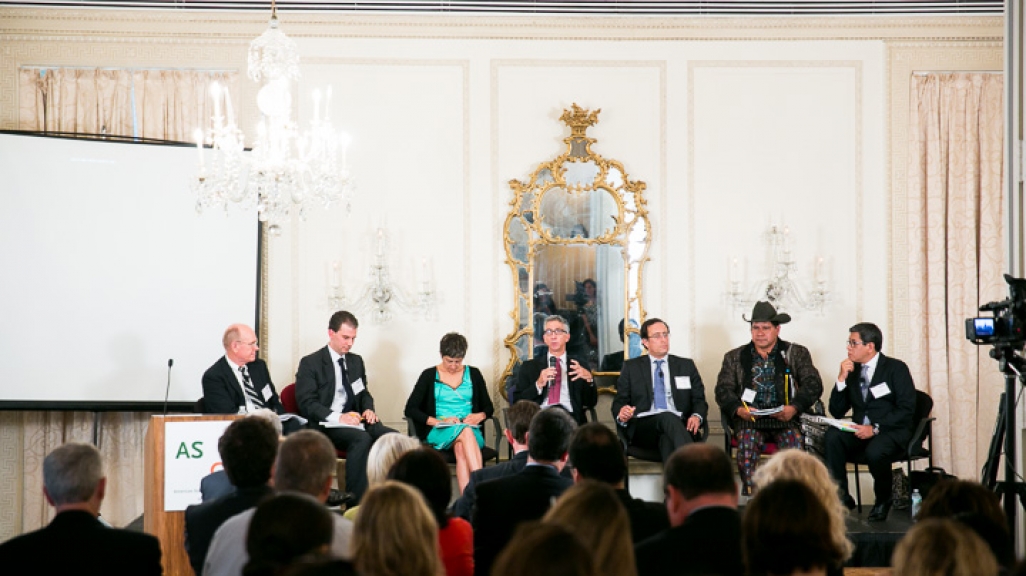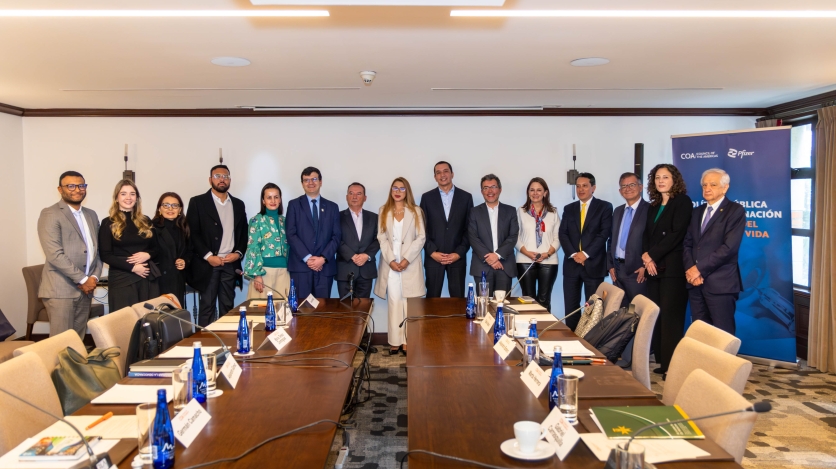Summary: The Perils and Promise of Consulta Previa
Summary: The Perils and Promise of Consulta Previa
Experts shared experiences on how Latin American countries consult indigenous communities on development projects.
Speakers:
- Alberto Chumil Julajuj, Indigenous Ancestral Mayan Authority Sololá (Guatemala)
- Francisco Borin Graziano, Corporate Affairs Director for Construções e Comércio Camargo Corrêa S.A.
- Ivan Lanegra, former Vice Minister of Intercultural Affairs, Peru; Professor of political science, Pontificia Universidad Católica del Perú and Universidad del Pacífico
- Robert C. Thompson, author of “Reducing the Financial Risk of Social Conflict” in the Spring 2014 Americas Quarterly; human rights author/lawyer; former Associate General Counsel, U.S. Environmental Protection Agency
- Andrée Viana Garcés, former Director of Consulta Previa, Ministry of the Interior, Colombia; Professor, Pontificia Universidad Javeriana; consultant, Instituto de Estudios Sociales y Culturales (PENSAR)
- Francisco Veloso, Vice President of Corporate Affairs and Sustainability, Antofagasta Minerals
- Peter J. Johnson, Americas Society Board Member; Associate, Rockefeller Family and Associates (Opening Remarks)
- Christopher Sabatini, Senior Director of Policy, Americas Society/Council of the Americas and Editor-in-Chief, Americas Quarterly (Moderator)
Summary
On July 16, Americas Quarterly launched the Spring 2014 issue “The Perils and Promise of Consulta Previa,” which focuses on the challenges of implementing consulta previa (prior consultation) in Latin America.
Today, consulta previa is “one of the defining issues in politics, economics, and investment in the region,” said Christopher Sabatini, senior director of policy at AS/COA and editor-in-chief of Americas Quarterly. While many Latin American countries adopted International Labor Organization (ILO) Convention 169—which recognizes indigenous and ethnic groups’ right to be consulted in advance on matters affecting their culture and heritage—enforcing the convention has proven a challenge. This is due to conflicts between indigenous communities, companies, and the state over concerns about violence and lost investments.
With the support of the Ford Foundation, Americas Quarterly investigated the evolution and implementation of consulta previa laws and regulations from 2013 to 2014, conducting a four-country research project in Chile, Colombia, Guatemala, and Peru. Along with interviewing community leaders, lawyers, government officials, and companies, AQ conducted a series of private roundtable discussions in each country to better understand the experiences, frustrations, and successes of all parties involved in consulta previa.
The July 16 panel brought that conversation to a U.S. audience, convening a diverse group of experts from Brazil, Chile, Colombia, Guatemala, and Peru to discuss each country’s progress and consider ways to strengthen consulta previa processes in Latin America.
Legal Challenges of Consulta Previa
Countries in the hemisphere have taken various approaches in the legal implementation and regulation of consulta previa. In fact, Peru is the only country to adopt a law that specifically grants the right of consulta previa to indigenous communities. Colombia and Chile, for example, have jurisprudence, decrees, ordinances, and directives to guide consultations, but no overarching national consulta previa laws. Francisco Borin Graziano, director of corporate affairs at Brazilian infrastructure company Camargo Corrêa, noted that the Brazilian government does not yet regulate consulta previa according to ILO 169, although Brazil’s indigenous communities have a constitutional right to maintain their culture and territory.
Andrée Viana Garcés, former director of consulta previa in Colombia at the Ministry of the Interior, pointed out that while the absence of a federal law in Colombia could create legal uncertainty, it could also be an opportunity that enables indigenous communities to propose their own protocols on consulta previa according to their local customs. However, other panelists stressed the importance of clear national laws and regulations to govern consulta previa.
Ivan Lanegra is the former vice minister for intercultural affairs in Peru who was instrumental in creating the country’s consulta previa law. He noted that consulta previa differs from other forms of popular consultation because it involves indigenous and tribal peoples. Yet how the state defines who is indigenous varies between countries, and in the case of Peru, it is a subject to internal controversy. Lanegra said that in Amazonian communities, consulta previa has been more successful compared to in Andean communities, where progress has been slower due to a lack of clarity about who qualifies as “indigenous.”
The Role of the State in Consulta Previa
Panelists agreed that the role of the state is central to consulta previa. Viana Garcés emphasized that the indigenous community and the state represent the two protagonists in consulta previa—even though other parties, such as the private sector, play important supporting roles. Graziano agreed, saying: “The state has to be there first, understanding what [communities]need and how they can help them…before the project exists.”
The state must also clarify which projects should be subject to consultation, and which should be subject to communities’ consent, said Lanegra. “Certain indigenous rights are protected to the extent that, unless the people give their consent…the state cannot move forward and use those territories.” As long as those rights lack clear definition, investments will remain subject to risk, he said. As one audience member later pointed out, all sides must understand that consulta previa is a right guaranteed by ILO 169 which Brazil, Chile, Colombia, Guatemala, and Peru all ratified.
The Private Sector’s Stake in Consulta Previa
Some panelists expressed admiration for Peru’s law and regulations on consulta previa and voiced concern about a lack of legal certainty for investors. According to Veloso, the Chilean Supreme Court has been inconsistent in its decisions on cases involving mining projects, resulting in $33 billion in lost revenue for projects that could not go forward because of court rulings.
Garcés Viana added that consulta previa can entail a financial risk because “it’s impossible to budget how much a consulta previa process will cost” when every process is different and outcomes are unpredictable. She said that Colombia tried to reduce the risk by analyzing different consultations in the same communities and regions, as well as projects of similar sizes. But she added that “when the companies encounter a ‘no’ from the communities, consulta previa can take years.” States must determine whether to proceed with caution in such cases, or else establish protected areas for indigenous communities where extractive activities are not permitted.
Panelist Robert C. Thompson is drafting new banking regulations in Peru that require investors to evaluate the risk of social conflict in their investments, asking companies to take steps to address potential risks. He stressed the economic importance of carrying out effective consultation processes in countries like Peru. “It’s so important that the companies and the banks grasp this issue because it’s in their own interest,” Thompson said. “If they’re going to get their loan paid back and the mine operating, their social license has to be firmly implanted.”
Participants agreed that consulta previa provides an opportunity for a long overdue dialogue between the state and indigenous communities. When asked to describe the characteristics of an effective consulta previa, Alberto Chumil Julajuj replied that from the Mayan perspective, the key is “respect and consensus” for each community, and that everyone must come to an agreement. Graziano added: “There will be compromise from the investment point of view and community point of view. That is part of the ‘good faith’ behind the process we are discussing.”









